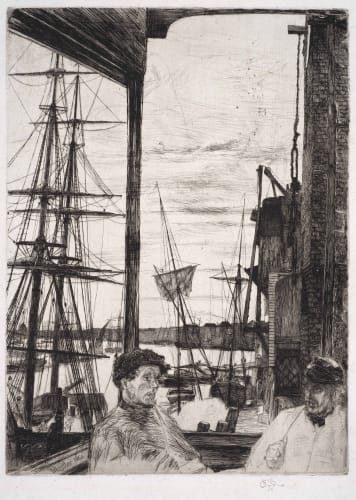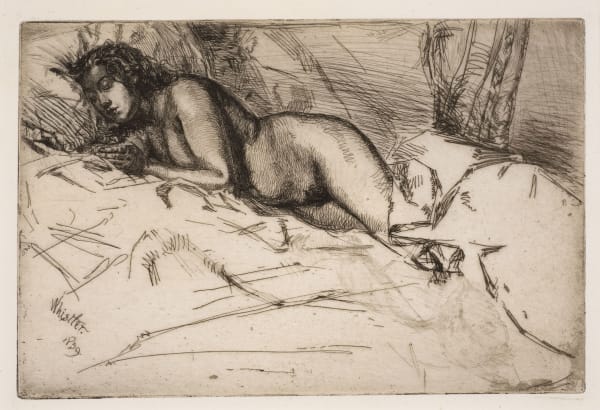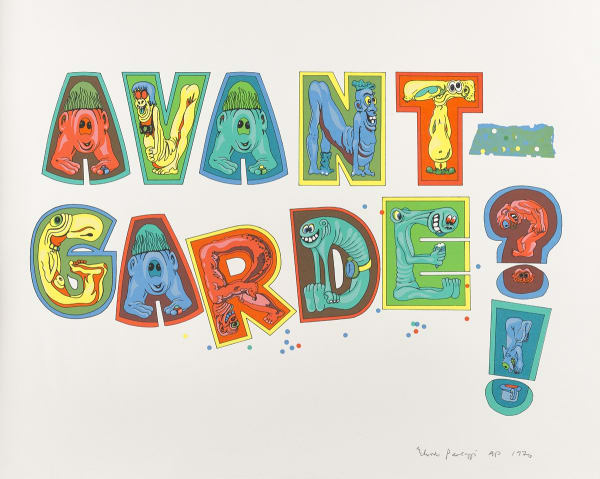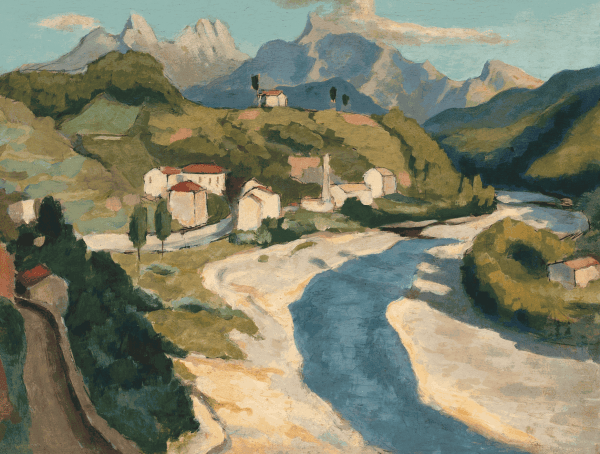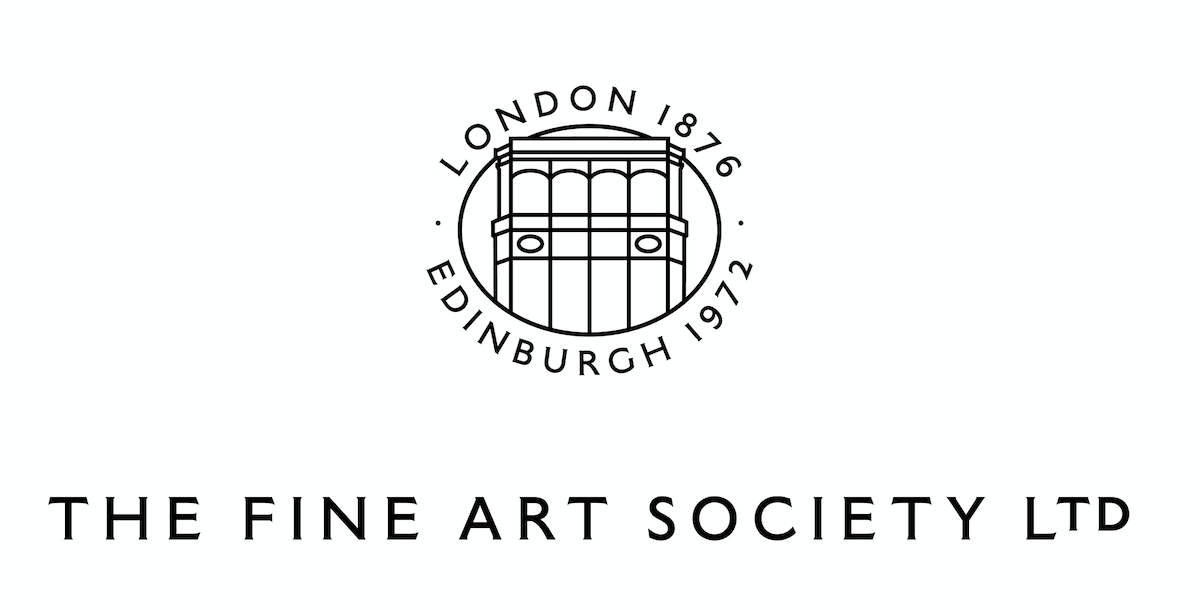James McNeill Whistler 1834-1903
James McNeill Whistler is one of the first and most illustrious artists to show in our galleries. As a painter in oils and in watercolour, as an etcher and a lithographer, Whistler excelled. He also made a stand for the cause of art for art’s sake, and this cost him dear. Although he won the case, he was bankrupted by the costs of his libel action against the critic John Ruskin. Ruskin had complained about Whistlers Nocturne in Black and Gold: The Falling Rocket, saying ‘I have seen, and heard, much of Cockney impudence before now; but never expected to hear a coxcomb ask two hundred guineas for flinging a pot of paint in the public’s face.’ Whistler was incensed and decided to sue Ruskin for libel. Although he had lost many of his possessions, he was still much adored by his colleagues and friends. This included our first managing director and gallery manager: Marcus B. Huish and Ernest Brown, who agreed to finance Whistler’s stay in Venice to work on a set of twenty etchings exclusively for The Fine Art Society.
We are actively seeking consignments of work by Whistler. Please contact us with details or to enquire after available works by this artist.
-
 James McNeill WhistlerNocturne, 1879-80signed in pencil with the butterfly and inscribed 'imp', printed in brown ink on laid paper, trimmed at the platemark by the artist, leaving a signature tabetchingan impression in the ninth (final) state: published in an edition of 100 in 'Venice: Twelve Etchings', 18807 ¾ x 11 ½ inches
James McNeill WhistlerNocturne, 1879-80signed in pencil with the butterfly and inscribed 'imp', printed in brown ink on laid paper, trimmed at the platemark by the artist, leaving a signature tabetchingan impression in the ninth (final) state: published in an edition of 100 in 'Venice: Twelve Etchings', 18807 ¾ x 11 ½ inches -
 James McNeill WhistlerPenny Passengers, Limehouse, 1860signed in pencil with a butterfly and inscribed 'imp', printed in black ink on laid paper, trimmed at the platemark, leaving a signature tabetching and drypointan impression in the second (final) state, one of only six recorded3 ¼ x 8 ⅛ inches
James McNeill WhistlerPenny Passengers, Limehouse, 1860signed in pencil with a butterfly and inscribed 'imp', printed in black ink on laid paper, trimmed at the platemark, leaving a signature tabetching and drypointan impression in the second (final) state, one of only six recorded3 ¼ x 8 ⅛ inches -
 James McNeill WhistlerVenus, 1859printed in black ink on laid paperetching and drypointan impression in the second (final) state: there was no published edition6 x 9 inches
James McNeill WhistlerVenus, 1859printed in black ink on laid paperetching and drypointan impression in the second (final) state: there was no published edition6 x 9 inches
Whistler was born in America, started drawing classes at the Imperial Academy of Fine Art in St. Petersburg, moved to Paris in 1855 to further his studies. His highly influential and individual style was inspired by many sources, including Japanese Art and ancient Greek Sculpture, and he was a leader in the Aesthetic Movement, promoting and writing on the “art for art’s sake” philosophy. Making prints was central to Whistler’s art. The first of his works accepted for exhibition at the Paris Salon and the Royal Academy were not paintings but etchings: the young artist came to see printmaking as the avenue to fame and success.
He was the first American artist to enjoy an international reputation and before his fellow Americans began to collect their work, he was a friend of Degas, Manet, Monet and the other leading artists working in Paris in the middle of the nineteenth century. When he sent his most famous work, Arrangement in Grey and Black: Portrait of the Painter’s Mother to the Paris Salon in 1883, the courier was his young assistant Walter Sickert. Whistler gave him introductions to Degas and Manet. It was in Paris that Whistler chose to begin his life as an artist. He arrived in the city in 1855 as a revival of interest in etching was gathering pace. Charles Meryon’s etchings of Paris had recently been shown at the Salon and Auguste Delâtre had set up as a printer.
Within our building Whistler staged his sensational show Arrangement in White and Yellow in 1883 which was to affect exhibition design radically so that his principles still guide curators today, more than 130 years later. The walls of the ground-floor galleries of The Fine Art Society in 1883, with his etchings floating in their mounts in white frames on walls covered with white felt. Elsewhere in the building we offered prints made by professional engravers which reproduced paintings by the leading artists of the day, in substantial black and gilt oak frames.
He was equally a pioneer in the print market, and produced a signed, limited edition of his Venice etchings in 1880, the prototype for print publishing of the future. When his career was in ruins in the aftermath of the Ruskin trial and his bankruptcy, it was a commission to make prints which brought him back to public notice. The exhibition he staged at The Fine Art Society in 1883, Arrangement in White and Yellow, which was to influence display and exhibition design for years to come, was a show of his Venice etchings.
-

Scottish Impressions
6 Jun - 31 Aug 2024Our summer exhibition opens with an exquisite example of Pre-Raphaelite painting by Waller Hugh Paton. Sublime evening light suffuses the scene which takes in a moored boat on a loch...Read more -

20th Century Printmaking
1 Feb - 16 Mar 2024Read more -

Master Drawings New York
at Robert Simon Fine Art 20 - 28 Jan 2023An exhibition of British and Scottish pictures from the nineteenth and twentieth centuries and decorative art and furniture from the late nineteenth century: prints by James Whistler; a group of...Read more -

Twenty Twenty
2 Oct - 14 Nov 2020The Fine Art Society is now almost 145 years old and has survived two world wars, depressions, a financial crash and, most recently, a global pandemic. The decision to relinquish...Read more -

James McNeill Whistler
The Original Printmaker 19 Jun - 25 Jul 2020James McNeill Whistler was one of the first and most illustrious artists to show in our gallery’s history. The Fine Art Society was the scene of one of his greatest...Read more
